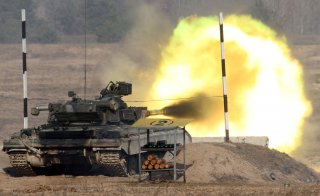Oldie but a Goodie: Meet Ukraine's Upgraded T-64BM Bulat Tank
Moscow doesn't like this.
Key point: Kyiv has found a way to make its aging tanks still useful on the battlefield. Here's what they've done to make them better.
With the war in eastern Ukraine dragging into its sixth year, the government in Kiev is buying upgraded models of a Cold War tank in an effort to outmatch Russia-backed rebels.
This first appeared in 2019 and is being reposted due to reader interest.
The Ukrainian army has acquired around 150 “T-64 2017s” since 2018, Radio Free Europe reported.
The T-64 is unique among Soviet-style tanks. A departure and major advancement compared to existing tanks when it first appeared in the early 1960s, the T-64 actually is more Ukrainian than it is Russian. The Lviv Tank Plant factory that builds the T-64 is in Ukraine. And today the Ukrainian army is the major user of the type.
Another major user is the rebel army in eastern Ukraine.
The T-64 introduced a number of advancements, including a new diesel engine. It also replaces the human loader with an automatic device for ramming shells into the breech, reducing the overall crew to just three people and saving weight. The T-64 was the first Soviet tanks with the now-standard 125-millimeter smooth-bore cannon, which in upgraded T-64Bs can fire a guided missile through its tube.
The Soviets never exported the T-64, preferring to sell cheaper, simpler T-55s, T-62s and T-72s. Throughout the later decades of the Cold War, thousands of T-64s equipped Soviet armies, primed to wage apocalyptic tank war with American M-1s, German Leopards and British Challengers.
The T-64 was more than adequate to the task. “This particular tank was provided with certain capabilities that were more advanced than NATO tanks that would not appear for an additional 15 or 16 years,” U.S. Army major James Warford concluded in a 1992 thesis.
When the Soviet Union broke up, Ukraine inherited hundreds of T-64s … and the factory that built the tanks. The rebuilt T-64BM Bulat introduced new armor and a so-called “active defense” system than shoots projectiles in order to intercept incoming rockets. The current T-64 2017 adds modern thermal imagers, secure digital communications and satellite navigation.
When eastern separatists—armed, supplied and reinforced by Russian agents—rose up in April 2014, demanding to split away from Kiev and join Moscow, Ukraine sent T-64s into combat.
And thanks to Russia, so did at least one rebel group. In June 2014, NATO published satellite imagery supposedly showing unmarked T-64s crossing from Russia into Ukraine. Six days later, Twitter user @mstyslav9 posted a photo they claimed depicted a T-64 belonging to the Donetsk People’s Republic separatist army.
It’s possible Moscow sent T-64s because it could then convincingly argue that the rebels had gotten the tanks from Kiev’s armories, rather than from Russia.
To clarify that the T-64s are not stolen Ukrainian examples, the Ukrainian government showed off a captured rebel T-64. “T-64BV under this serial number was issued in October 1987 at the Kharkov Tank Factory and sent to a military unit, which at that time [was] stationed in Russia,” Kiev asserted, according to Jane’s.
The Ukrainian government added that it had traced newly-built components on the tank to a factory in Saint Petersburg, Russia.
Jane’s concluded that the rebels possessed at least three, and as many as “double figures” T-64s—but cautioned against alarm. “The presence of [main battle tanks] operating in rebel hands is undoubtedly a highly unwelcome development for the Ukrainian military, however their practical utility may be limited.”
“Unless supported by combined arms forces, [main battle tanks] can prove highly vulnerable to attack from air power, infantry armed with anti-tank guided weapons and other MBTs,” Jane’s stated. “Additionally, they require a significant supply chain to maintain in the field.”
In light of tanks’ huge appetite for fuel, parts and repairs, it makes sense that Russia would supply T-64s to its rebel proxies instead of other tank models. The T-64 is, more than anything else, a Ukrainian tank—having been manufactured in that country. Rebels shouldn’t have too much trouble finding local people who can help maintain the vehicles.
But with recent upgrades, Kiev’s T-64’s are much more sophisticated, and possibly more reliable, than the rebels’ own T-64s are.
David Axe serves as Defense Editor of the National Interest. He is the author of the graphic novels War Fix, War Is Boring and Machete Squad. This first appeared in 2019 and is being reposted due to reader interest.
Image: Reuters

